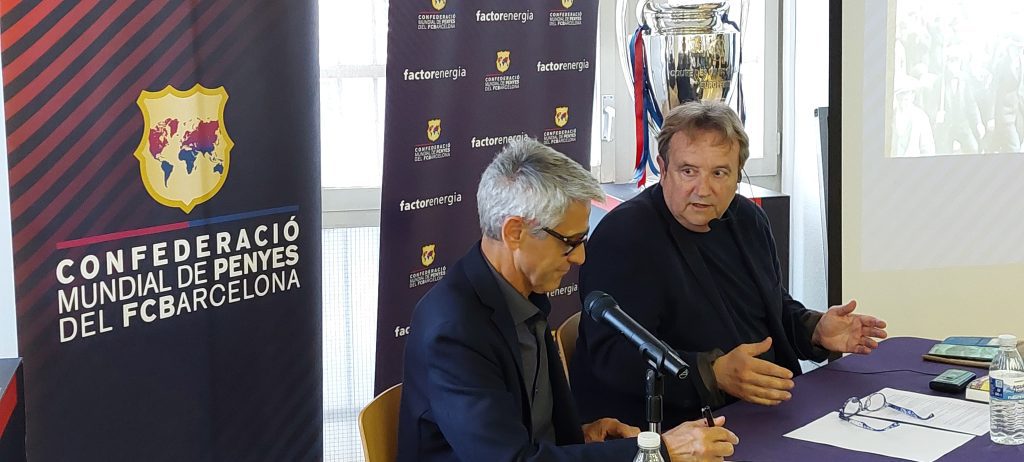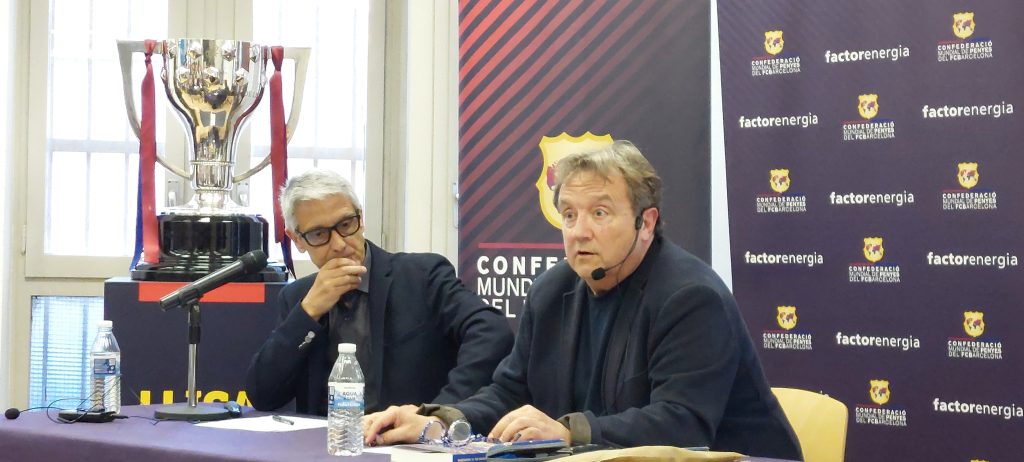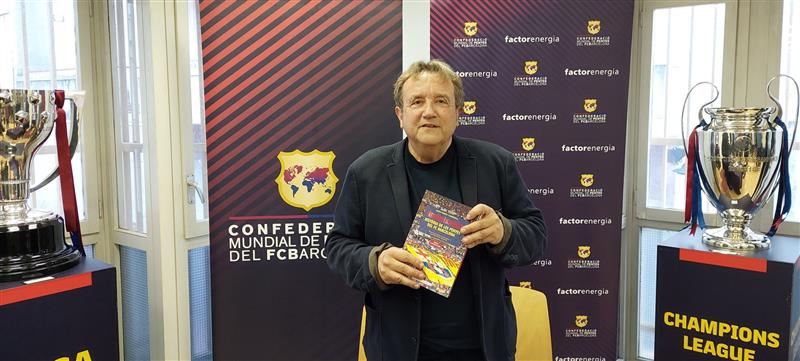On 20 April, the first exclusive book on the history of the FC Barcelona penyes was published. Under the ‘Ambaixades’ title, this work will consist of three parts, the first of which was presented on Tuesday 22 April at the headquarters of the Confederació with more than 100 attendees.
We have already talked about that successful event in the news of the Confederació and in the media. Today, Aksana Vayevoda, philologist, psychologist and collaborator and presenter of events of the Confederació Mundial de Penyes del FC Barcelona, interviews the author Salva Torres to explain the content of the book:
Aksana: Salva, how did you come up with the idea of writing an exclusive book about the history of the penyes?
Salva: It all started with the ‘Barça i Catalunya’ talks, where we also wanted to show that the penyes already existed in the 1920s and had a lot of activity. We found so much information that we decided to create a conference only about the history of the penyes. And, as in the “Barça i Catalunya” case, the first issue of the book was born. There will be three volumes.
A: I had understood that the first supporters’ clubs were related to the name of Nicolau Casaus and came out after the Spanish Civil War, but reading the book I see that this is not the case. Can you explain it to us?
S: Indeed, in the 1920s there were already many penyes with a very significant level of activity, I don’t understand how this fact could have been silenced for so many years. In fact, Nicolau Casaus does not appear with the Penya Solera after the war, but he is already quite active in 1931 in a penya in Igualada called Penya Barcelonista Germanor.
A: You’re talking about three types of penyes throughout history?
S: Yes, the penyes were initially sports penyes with their football teams, but alongside them a more social demand was growing, more involved in cultural and even political activities. Over time, there are or have been social penyes, sports penyes and, more recently, solidarity penyes, without preventing a single penya from maintaining two or all three aspects.
A: And we found a surprise: the first international penya.
S: It was thanks to the collaboration of Joan Vinyals who told us about it. And it was in the former Soviet Union, specifically the Penya Barcelonista de Leningrad, founded in the year of the Basel final and which, with time and the fall of the Iron Curtain, became Penya Barcelonista de San Petersburg.
A: You also discovered the longest-lived penya in history, with an unpleasant ending…
S: The Penya Gol de Dalt was officially created in 1935, which made it, already in the 21st century, the oldest supporters’ club among all the movement. Unfortunately, due to circumstances that have yet to be clarified, it disappeared in 2014. It was a pity, because other information already unofficially dated this penya back to the 1920s.


A: Another very important and unique event for was the creation of the Confederació Mundial de Penyes del FCB in 2015. How did the idea come about?
S: Two years earlier, the 30 territorial federations had been created and made official, covering the 5 continents, with 30 presidents or representatives from each federation. It was necessary to vote for a representation of the whole structure, a president of the Penyes Council democratically elected by its members. This president would in turn choose a Board of Directors, which would serve as a representation of the whole movement. If we wanted to negotiate with the FCB Foundation, with the Players’ Association, with the universities, with Aficiones Unidas or with UEFA itself, all thirty presidents could not go. Therefore, this representation closes a project of Penyes Segle XXI called Confederació Mundial de Penyes del FC Barcelona. As I said: a unique structure in the world.
A: What message do you want to convey to penyes, supporters and FC Barcelona fans in general?
S: There is only one: to value the great treasure that we have with the existence of our penyes, all with different tasks or idiosyncrasies; those in Barcelona on the one hand, those outside Barcelona, and the international penyes. The penya members, the Club members or the fans in general have to know when he travels where he can find a home where he will be very well received, sometimes in the most unthinkable corners of the planet. And those from abroad need to know that in Barcelona there are many penyes with sporting activities which, in some cases, have served to discover future FC Barcelona values. Not forgetting the great solidarity work done by the penyes, helping the neediest sectors of society.
A: And with all these great aspects that you explain, how is it that there is currently this estrangement from the FC Barcelona board?
S: I honestly don’t know, and I don’t understand. You would have to ask them. I personally invited some of them to the presentation of the book because I think it is preferable to build bridges than to dig trenches, but only the vice-president Antonio Escudero answered me, very kindly, excusing his absence for some meetings already scheduled. It was a nice gesture.
A: Well, we hope that these bridges are built quickly because in the end, the penyes, the federations and the Confederation are nothing more than a great asset of FC Barcelona. Thank you very much for the book and we hope it will be a great success among supporters, while we wait for the other two volumes you have mentioned. Do you have anything else to add?
S: I would just like to thank so many people who have collaborated with the book, the penyes who have sent us more than 700 reports and the members of the Advisory Council for their great involvement.







